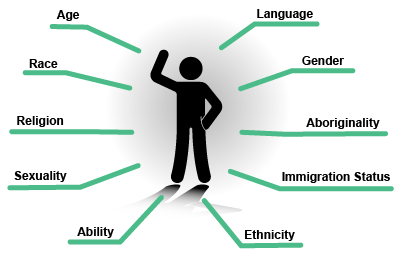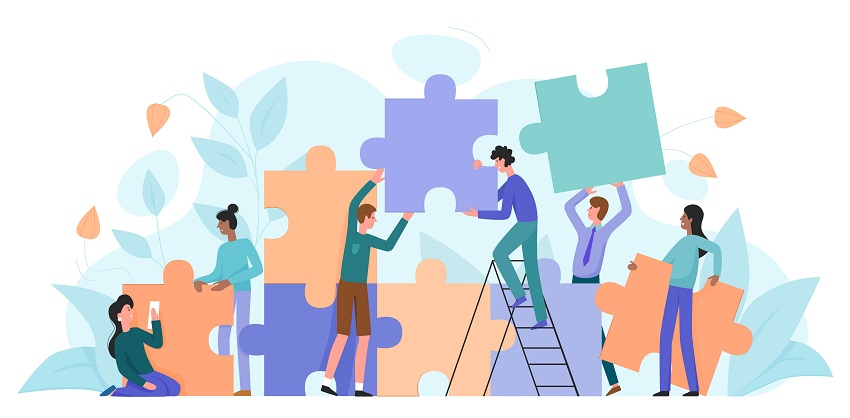
LHR136: Race, Gender, and Employment
Lesson 01
L01 Overview
This course is an exploration of how race and gender influence, and are influenced by, employment. In this first lesson, we introduce the basic concepts of this course.
Learning Objectives
After completing this lesson successfully, you will be able to:
- Explain how race, gender, and other demographics are interrelated and influence the workplace.
- Discuss changing demographics in the U.S. and the associated effects on workforce diversity.
- Differentiate among diversity, discrimination, and their interrelationships.
- Describe research on the individual and organizational benefits of diversity.
Readings and Resources
For this lesson, read/view the following:
- Course Orientation
- This module contains a discussion where you can introduce yourself to and learn more about your classmates.
- Lesson 01 content
- Myrtle Bell, Diversity in Organizations (5th ed., 2025), Chapter 1: Introduction
- "New report from members of The Washington Post’s union shows women and people of color are paid less.", Courtney Connley, CNBC, Nov. 7, 2019
Assignments
For this lesson, complete the following:
- L01 Discussion on Supporting Diversity
- This assignment has two parts: Initial Post and Reply Posts
L01 Terms to Know
The following is a list of terms, found on these pages and the assigned readings, with which you should be familiar by the end of this lesson:
- Ability (as a source of discrimination)
- Access discrimination
- Age discrimination
- Appearance (as a source of discrimination)
- Consumer racial profiling
- Discouraged workers
- Discrimination
- Diversity
- Diversity climate
- Employment discrimination
- Ethnicity
- Family structure (as a source of discrimination)
- Gender salary gap
- Identity groups
- Inclusion
- Intersectionality
- Labor force
- Labor market discrimination
- Mental impairment
- Participation rate
- Physical impairment
- Productive characteristics
- Protected classes
- Racial salary gap
- Religion (as a source of discrimination)
- Treatment discrimination
- Underemployed
L01 Introduction
You probably lived through, maybe even experienced first-hand, the racially motivated events that took place in the year 2020. The names George Floyd, Ahmaud Arbery, and Breonna Taylor circulated in the world news; each of them was an African American whose life was lost to police brutality in the U.S.
Unfortunately, police violence is not the only type of oppression that African Americans, Hispanics, Native Americans, and other minorities experience in the United States. Indeed, most countries of the world can identify minority populations that face unethical, and often illegal discrimination at the hands of those who are supposed to protect them, help them to rent or buy a house, interact at their workplaces, and in many other social interactions.
For the purpose of this course, we are interested in work or employment discrimination.

L01 What Is Discrimination?
According to the Merriam-Webster online dictionary, discrimination can be defined as “the act, practice, or an instance of discriminating categorically rather than individually” (http://merriam-webster.com/dictionary/discrimination).
The same dictionary reminds us that this word has “neutral, positive, and negative connotations.” Let’s look at this closer:
- In English, we might say that a person has a “discriminating taste” as a way to compliment their sophistication; this is the positive connotation.
- We might also use “discrimination” as another way to say “differentiation” or “distinction,” which is an example of the neutral connotation.
- Finally, when we talk about employment discrimination, we typically refer to a prejudicial or hostile type of treatment, often due to membership in a demographic group (such as age or religion); this is a negative connotation. This type of discrimination may be illegal, but not necessarily.
- For example, discrimination in employment due to race or sex is illegal, but a company that treats short, underweight, or mentally disabled employees differently (even if based on the fact that they belong to certain groups of people) does not necessarily break any laws.
Later, we will make a distinction how some laws prohibit workplace discrimination only at the state or local level, and others do so at the federal level.
One of the indicators of discrimination that is easy to measure and has many consequences is the racial salary gap; and it can be defined as the difference in wages between individuals of different races.

After the first quarter of 2020, the Bureau of Labor Statistics in the U.S. reported median weekly earningsinks to an external site. which showed that:
- African Americans earned 79.2% the earnings of Whites
- Hispanic Americans earned 73.7% of earnings received by Whites
- Asian Americans earned 124.7% those of Whites (while this is a higher rate of earning, Asian Americans are still victims of stereotypes and illegal discrimination)
These differences in median weekly earnings are not the exclusive result of illegal discrimination. Factors other than discrimination that affect weekly earnings include education, experience, company size, industry, location, and many more (Hallock, 2012). When individuals of one particular race happen to have more education or experience in their organizations, it is not unfair, much less illegal if they end up having different compensation levels.
The same can be said when organizations that serve certain industries or are located near the largest cities have more employees of one particular race. The differences in their wages are not considered illegal if they are the result of economic or market forces.
Although statisticians have developed methods to measure the effects of those factors, scientific methods have not been able to discard the possibility that illegal discrimination is one of the non-market reasons why such gaps in earnings exist (Bell, 2025).
Sex is another demographic characteristic for which discrimination has been prohibited since the Civil Rights Act of 1964 was signed into law. This law prohibits discrimination in employment based on sex, race, and other characteristics.
Unfortunately, a gender salary gap also exists, meaning that women on average make less money than men. Despite more than five decades of legal protection against discrimination in wages, women’s median weekly earnings in the first quarter of 2020 were 80.4% of men’s. While it is true that this gap has decreased (from 58.9% of earnings by men in 1963.), research suggests that the current rate of progress would not give women equality in salaries until 2059.
Some large organizations, including The Washington Post and Citigroup, have analyzed their own payrolls, to find that race and gender salary gaps exist within their firms. Your assigned article for this week, Connley’s (2019), offers a summary of such findings.

L01 Impact of Privilege and Discrimination
To make things worse, demographic characteristics have a compounded effect when it comes to salary and other types of discrimination; this is often referred to as intersectionality. One way to explain this concept is when individuals have more than one demographic characteristic, social or political identity that has traditionally been discriminated against or privileged, the effects of such combinations are greater than they would be in isolated fashion. 
For example, it was shown earlier that African Americans and Hispanic Americans earn a fraction of Whites’ median earnings. When we examine the same numbers by gender, the pay gap increases:
- African American women’s median earnings are 67.6% of White males’
- Hispanic women’s median earnings are 61.9% of White males’
- Conversely, Asian American males make 124.1% of their White counterparts, but Asian women only 100.1% of White men, which statistically might not be different
Groups that share these characteristics are known as “protected classes”, an important term in our course. An essential reason why individuals in these groups are protected by law against discrimination in all employment phases is that, historically, they have been excluded from access to opportunities in a manner that is unrelated to work needs. Both for privilege and for discrimination, having more than one of these characteristics is likely to have compounded measurable effects for individuals in our society.
Being aware of the existence of privilege and discrimination and their consequences is the first step we need to create more inclusive workplaces. Inclusion is another term for just, equitable, and is based on personal merits and business needs, instead of characteristics that an individual is unable to control.
Next, we look at other demographics that can also be sources of discrimination.
L01 Other Sources of Discrimination
Even though Race and Gender are the most obvious demographic characteristics perceived as sources of discrimination, there are at least five more major characteristics which powerfully affect not just salaries, but other work-related processes and outcomes. These are family, religion, age, ability, and appearance. We will study each of them in-depth later in our course, but for now, let us review a quick description of each.
Family structure interacts powerfully with gender, because of the roles that women have traditionally played within their families. It is true that our society has become more accepting of husbands and male partners taking care of children, sick, or older family members, while wives or female partners are the breadwinners. But the fact remains that most families in the U.S. (and around the world) rely on women for household responsibilities and on men for earning money for sustenance.
Religion is the system of beliefs, practices, knowledge, and feelings that individuals hold to understand or complement what science and observations are unable to explain, particularly as they relate to what is considered sacred. Because of the way the U.S. was founded, freedom of religion is enshrined in the first amendment to the Constitution. But the way this freedom is understood and enacted is often another source of discrimination or privilege.
Age discrimination occurs more often at the later and the earlier stages of participation in the workforce, but old-age discrimination is the only one that has legal protection at the federal level. Later in this course, we will examine evidence demonstrating that a great deal of stereotypes and expectations about individuals outside the conventional working ages are unfounded. This implies that the current legislation forbidding discrimination against individuals within certain age brackets is well-founded, but more might be needed, especially now that our life expectancy and the “shelf-life” of productive workers continues to increase.
Ability is the term that we use to refer to the temporary or permanent physical or mental departures from what society considers the norm based on health. Some examples of this include vision, hearing, motion, and similar physical impairments, as well as autism, learning, and other mental impairments. Most individuals experience at least a temporary disability during their life; this justifies the existence of accommodations that can be extended to others with more permanent disabilities without a large effort on the part of society and employers. Unfortunately, perceptions of inadequacy based on ability prevail in society, often despite scientific evidence that refutes them; this justifies our exploration of these issues.
Appearance is another important category that strongly affects work processes and outcomes in ways that, similar to the above, are often unfair and hard to justify. In a later lesson, we will review studies that show how weight, height, beauty, and similar factors related to appearance affect and are affected by workplace decisions. As in the previous cases, most studies concur that these disparities are morally unjustifiable and often have no validation from a business perspective.
This is not an exhaustive list; other factors (e.g., rural versus urban company setting, industry) might also explain not just the gaps in salary, but also in promotions, development opportunities, benefits, disciplinary actions, and other terms of employment. In fact, even before a person becomes an employee, they might be discriminated against in terms of landing interviews, receiving callbacks, and other employer activities that impact work satisfaction, commitment, and productivity.
L01 Benefits of Inclusion and Diversity
A very basic reaction to the identification of these employment disparities is that they should be eliminated because they are unfair: people ought to be treated the same, irrespective of their differences or their diversity. This is perhaps the most basic understanding of inclusion, which is a higher standard than simple “tolerance”.
At the same time, most of us would agree that those who work harder or offer some unique value to their employer deserve to be compensated better than those who do not. In order to survive and thrive, employers have to be willing to reward some of their workers more generously than others. 
A very influential study written by Taylor Cox and Stacey Blake-Beard (Cox & Blake, 1991) explains six specific, recognizable business reasons for organizations to value diversity: cost, resource acquisition, marketing, creativity, problem-solving, and system flexibility. You will be reading excellent summaries of these six reasons in your assigned textbook readings for this lesson. But those are not the only reasons why organizations should value diversity and strive to create climates where people—especially those who are not “typical” or representative of the majority—feel included, not just tolerated or brought in, for cosmetic reasons.
In this lesson’s assigned textbook reading, Bell (2025) also identifies three more areas for which diversity provides employers with competitive advantages: cooperative behaviors, financial returns, and positive interactions with organizational strategy. She also reminds us that these benefits are not automatic; there are difficulties such as negative perceptions about diverse workers (i.e., those who are different from the mainstream), particularly when those workers are first brought into the organization. Studies have shown that, with time and work-related interactions, these difficulties decline; “people stop attending to outward appearances and begin attending to work-related differences” (Bell, 2025).
Lastly, Bell reminds us that business reasons should not be the only motivation for us to study and better prepare ourselves to seek diverse and inclusive organizations. There are moral and social reasons as well, both for organizations and for individuals (Bell, 2025).
L01 Summary
This first lesson should give you a very good idea of what we will be learning in the coming weeks. This course has been designed to help you understand how discrimination at the workplace occurs and can be identified. Race, gender, religion, age, family structure, ability, and appearance are some of the factors that historically have been associated with negative individual and organizational outcomes. We have also previewed some of the benefits—and difficulties—accompanying a diverse and inclusive workplace.
This lesson’s discussion will foster an initial conversation between peers on why diversity, equity, and inclusion should be important aims for organizations of all types.